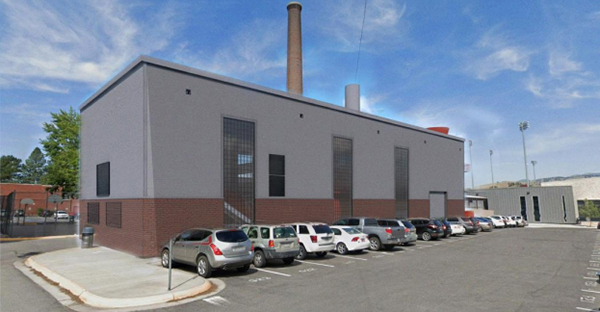UM Breaks Ground on New Power Facility, Slashes Emissions 30%
MISSOULA – With snow already dusting nearby Mount Sentinel, the University of Montana began construction this week on a new combined heat and power (CHP) facility that will provide electricity and steam to its buildings.
The new CHP will also save UM $1.5 to $2 million annually in reduced energy expenses. These savings will be directly invested back into student-facing infrastructure, such as new classrooms and upgraded labs.
The new facility will be located adjacent to UM’s historic steam plant and generate up to 5 megawatts with two natural gas turbines and a steam turbine. The heat recovery steam generator will use heat from the natural gas turbines’ exhaust to produce steam.

This rendering shows the new combined heat and power facility.
Combined heat and power, also known as cogeneration, is the concurrent production of electricity and heat from a single source of energy. UM currently operates a steam plant that burns natural gas to heat campus buildings. The existing steam plant includes three boilers that date from the 1960s and generate electricity and heat, but to a smaller degree than the new plant.
“CHP is a really unique and impactful project for UM because it involves updating existing historic campus infrastructure while adding a new modern cogeneration system that will allow UM to generate additional power savings, and save us money,” said Paul Trumbley, UM associate director of utilities and engineering. “The new CHP plant will be designed with multiple units and turndown capabilities, giving its operators plenty of flexibility when it comes to power production.”
This also means that, as UM continues to add more solar installations to campus, the CHP facility’s generation can be responsive. The plant will be capable of burning biogas or hydrogen, when available, making it possible for UM to someday generate a significant amount of its own electricity with non-carbon sources.
The design and construction of the facility is being led by energy services contractor McKinstry with input and direction from UM facilities engineers. The original idea for the project arose during a series of conversations between UM facilities engineers and Montana Department of Environmental Quality staff about on-campus energy project options. Five years and multiple feasibility studies later, the project caught the attention of Paul Lasiter, UM’s vice president for Operations and Finance.
Lasiter said the CHP was compelling because it will revitalize UM’s aging steam plant infrastructure, substantially reduce carbon emissions and generate significant energy cost savings.
Lasiter described the CHP as “a best-case scenario to be able to improve our existing steam plant, support our sustainability and emissions reduction goals and see significant savings on utilities costs all in one project.”
According to the MEPA assessment that was conducted by Bison Engineering for the CHP, once online the new turbines will result in a 30% reduction of UM’s greenhouse emissions, a more significant reduction than UM has been able to realize since first assessing and making public its GHG emissions back in 2009.
“We’ve seen our emissions footprint decrease as a result of investments in energy conservation and efficiency, but not 30%,” said UM Sustainability Director Eva Rocke. “Without a doubt, CHP represents the largest investment UM has made to date in technology and campus improvements that will have a direct and positive impact on our carbon footprint.”
More information about the University’s CHP plant is available online.
###
Contact: Eva Rocke, director, UM Office of Sustainability, 406-243-4323, eva.rocke@umontana.edu.